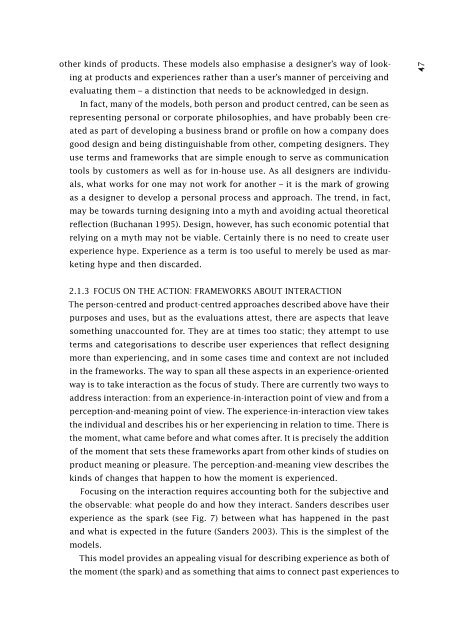Co-experience: Understanding user experiences in social interaction
Co-experience: Understanding user experiences in social interaction
Co-experience: Understanding user experiences in social interaction
You also want an ePaper? Increase the reach of your titles
YUMPU automatically turns print PDFs into web optimized ePapers that Google loves.
other k<strong>in</strong>ds of products. These models also emphasise a designer’s way of look<strong>in</strong>g<br />
at products and <strong>experience</strong>s rather than a <strong>user</strong>’s manner of perceiv<strong>in</strong>g and<br />
evaluat<strong>in</strong>g them – a dist<strong>in</strong>ction that needs to be acknowledged <strong>in</strong> design.<br />
In fact, many of the models, both person and product centred, can be seen as<br />
represent<strong>in</strong>g personal or corporate philosophies, and have probably been created<br />
as part of develop<strong>in</strong>g a bus<strong>in</strong>ess brand or profile on how a company does<br />
good design and be<strong>in</strong>g dist<strong>in</strong>guishable from other, compet<strong>in</strong>g designers. They<br />
use terms and frameworks that are simple enough to serve as communication<br />
tools by customers as well as for <strong>in</strong>-house use. As all designers are <strong>in</strong>dividuals,<br />
what works for one may not work for another – it is the mark of grow<strong>in</strong>g<br />
as a designer to develop a personal process and approach. The trend, <strong>in</strong> fact,<br />
may be towards turn<strong>in</strong>g design<strong>in</strong>g <strong>in</strong>to a myth and avoid<strong>in</strong>g actual theoretical<br />
reflection (Buchanan 1995). Design, however, has such economic potential that<br />
rely<strong>in</strong>g on a myth may not be viable. Certa<strong>in</strong>ly there is no need to create <strong>user</strong><br />
<strong>experience</strong> hype. Experience as a term is too useful to merely be used as market<strong>in</strong>g<br />
hype and then discarded.<br />
47<br />
2.1.3 FOCUS ON THE ACTION: FRAMEWORKS ABOUT INTERACTION<br />
The person-centred and product-centred approaches described above have their<br />
purposes and uses, but as the evaluations attest, there are aspects that leave<br />
someth<strong>in</strong>g unaccounted for. They are at times too static; they attempt to use<br />
terms and categorisations to describe <strong>user</strong> <strong>experience</strong>s that reflect design<strong>in</strong>g<br />
more than experienc<strong>in</strong>g, and <strong>in</strong> some cases time and context are not <strong>in</strong>cluded<br />
<strong>in</strong> the frameworks. The way to span all these aspects <strong>in</strong> an <strong>experience</strong>-oriented<br />
way is to take <strong>in</strong>teraction as the focus of study. There are currently two ways to<br />
address <strong>in</strong>teraction: from an <strong>experience</strong>-<strong>in</strong>-<strong>in</strong>teraction po<strong>in</strong>t of view and from a<br />
perception-and-mean<strong>in</strong>g po<strong>in</strong>t of view. The <strong>experience</strong>-<strong>in</strong>-<strong>in</strong>teraction view takes<br />
the <strong>in</strong>dividual and describes his or her experienc<strong>in</strong>g <strong>in</strong> relation to time. There is<br />
the moment, what came before and what comes after. It is precisely the addition<br />
of the moment that sets these frameworks apart from other k<strong>in</strong>ds of studies on<br />
product mean<strong>in</strong>g or pleasure. The perception-and-mean<strong>in</strong>g view describes the<br />
k<strong>in</strong>ds of changes that happen to how the moment is <strong>experience</strong>d.<br />
Focus<strong>in</strong>g on the <strong>in</strong>teraction requires account<strong>in</strong>g both for the subjective and<br />
the observable: what people do and how they <strong>in</strong>teract. Sanders describes <strong>user</strong><br />
<strong>experience</strong> as the spark (see Fig. 7) between what has happened <strong>in</strong> the past<br />
and what is expected <strong>in</strong> the future (Sanders 2003). This is the simplest of the<br />
models.<br />
This model provides an appeal<strong>in</strong>g visual for describ<strong>in</strong>g <strong>experience</strong> as both of<br />
the moment (the spark) and as someth<strong>in</strong>g that aims to connect past <strong>experience</strong>s to

















